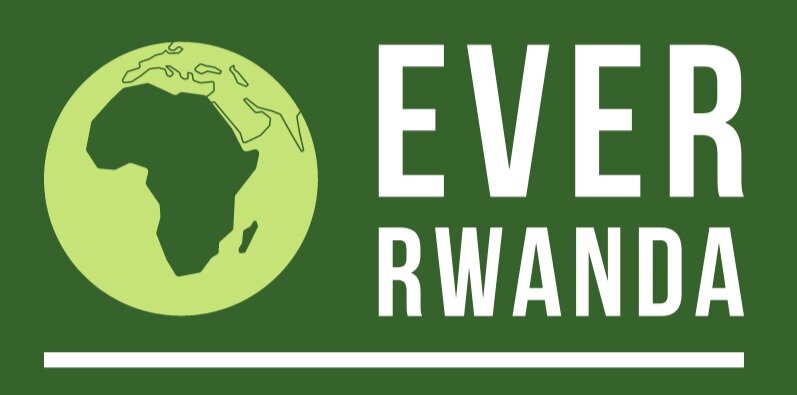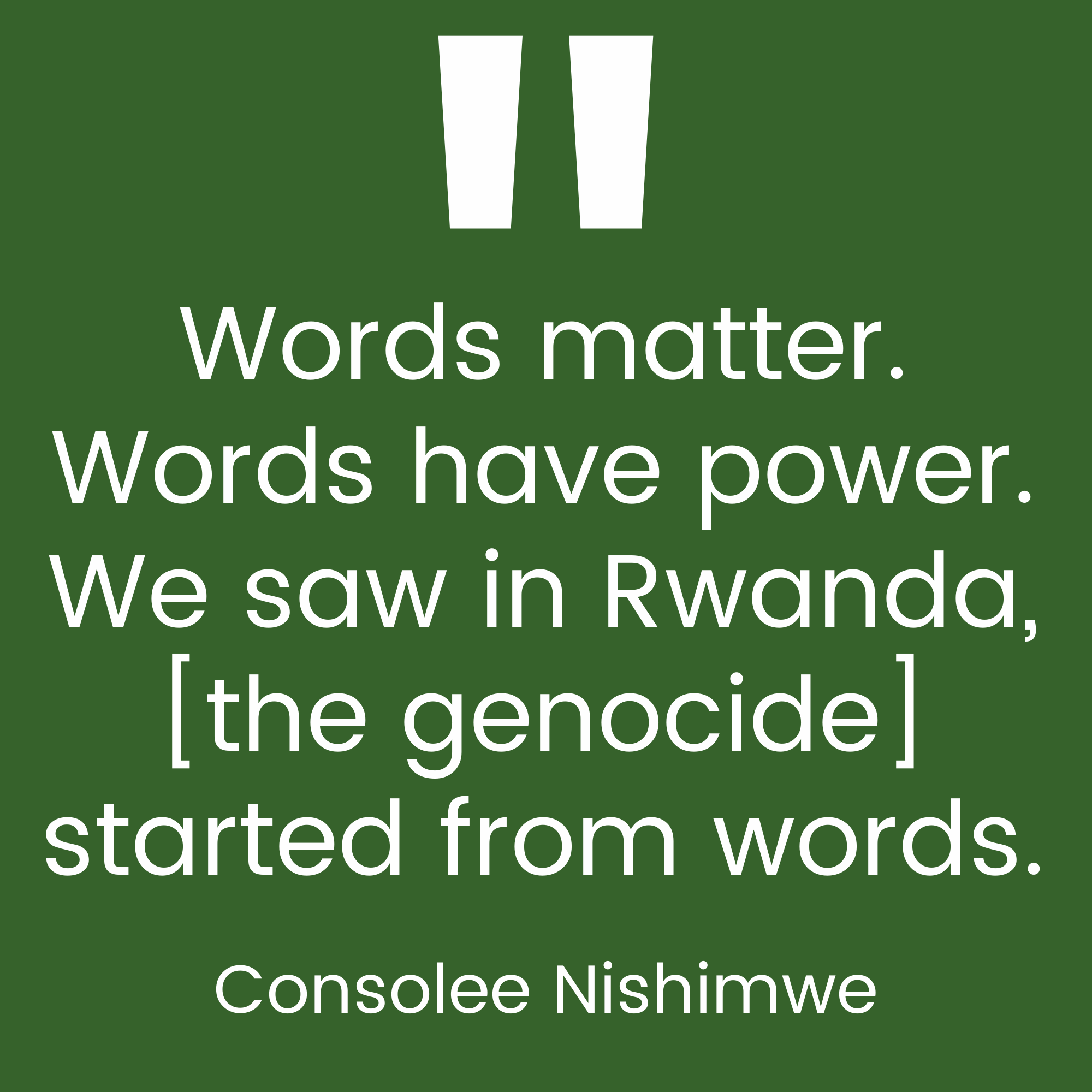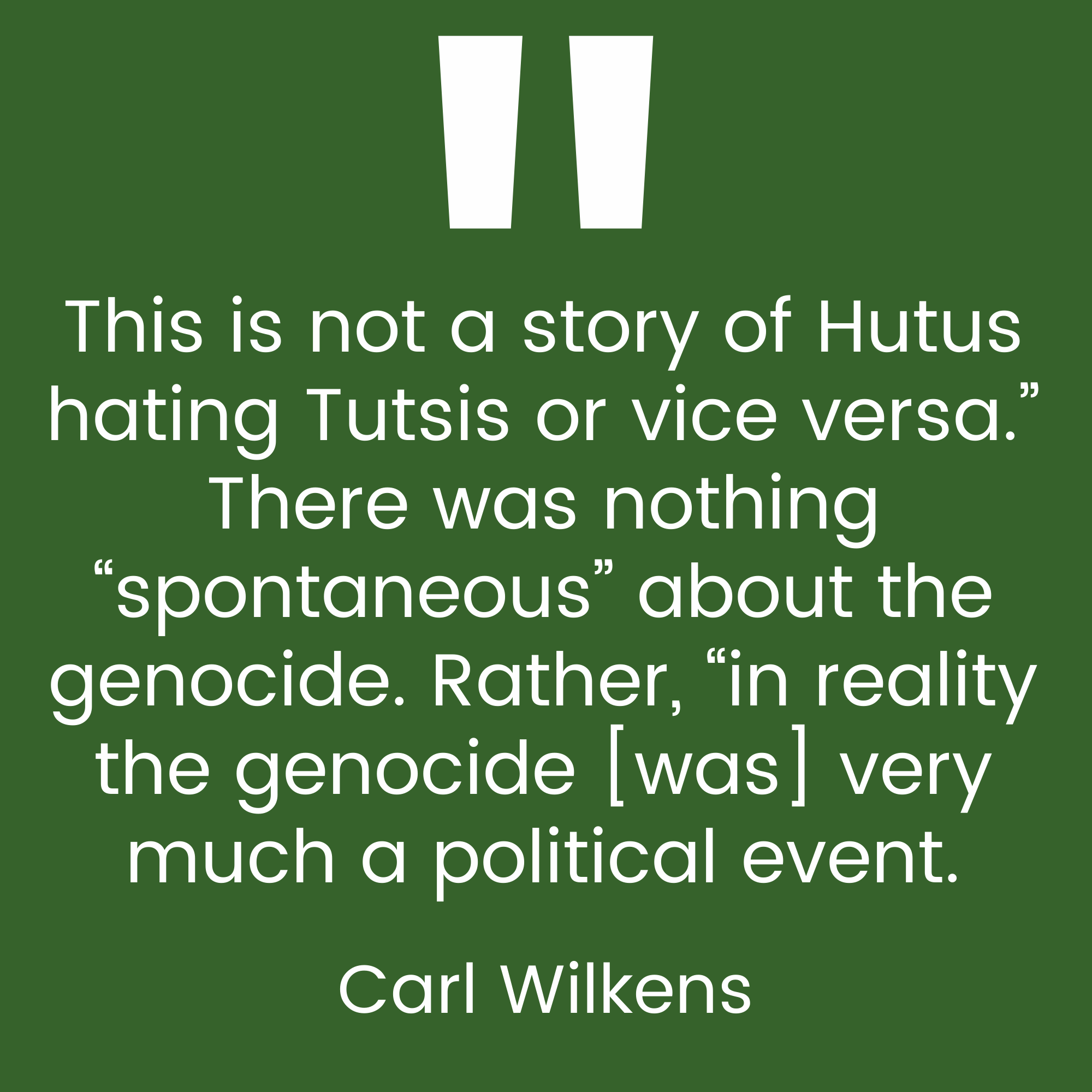Stages of Genocide
How the Genocide Against the Tutsi Followed a Predictable Pattern of Dehumanization, Discrimination, and Ultimately the “Extermination” of One Million People
The Rwandan genocide didn’t happen overnight. Every single survivor of the Genocide against the Tutsi and others that I intereviewed for this project expressed this exact same sentiment. Consolee Nishimwe survived the genocide at the age of only fourteen, along with her mother, Marie-Jeanne Mukamwiza, and younger sister, Jeannette Ingabire. Tragically, her beloved father, Andre Ngoga, and three younger brothers, Philbert Nkusi, Pascal Muvara, and Bon-Fils Abitmana were murdered. “Genocide doesn’t happen overnight,” she explained. “It’s a process. There are so many stages.” (Nishimwe, Consolee. Interview. Conducted by Emelia O’Neill, 18 February 2021). Like all genocides, there was a predictable pattern of classifying people to create an us versus them mentality, coupled with dehumanizing hate speech, which in the case of pre-genocide Rwanda negatively targeted the Tutsis. Ms. Nishimwe noted, “Words matter. Words have power. We saw in Rwanda, [the genocide] started from words.” (Nishimwe).
Dr. Tharcisse Seminega survived the genocide along with his wife and five children. He echoed these sentiments in explaining that, “in Rwanda genocide didn’t happen overnight. There was a long history of ethnic divide and intense hate propaganda that shaped the mentality of the whole population and prepared them to slaughter neighbors, friends, colleagues, in-laws, and inmates only because they looked different. Just imagine that you are targeted for slaughter because you are tall, have a long nose, have many cows, or simply because someone spread the idea that you are not Rwandan because you came from Ethiopia.” (Seminega, Tharcisse. Interview. Conducted by Emelia O’Neill, 22 April 2021).
Carl Wilkens was the only American to remain in Rwanda during the genocide. He shared his similar belief that there was nothing “spontaneous” about the genocide. (Wilkens, Carl. Interview. Conducted by Emelia O’Neill, 1 July 2021). Rather, “in reality the genocide [was] very much a political event.” (Wilkens). Mr. Wilkens observed that the “foundation” of the genocide was a “political power struggle” and when it is understood as a “politically constructed event” then it is clear that this did not have to happen. (Wilkens). Mr. Wilkens profoundly noted that, “Ordinary people don’t solve problems with genocide.” (Wilkens). Yet, an “external narrative” has the ability to become “internalized” with deadly results. (Wilkens).
Numerous other survivors of the genocide shared the signs or “stages” that they witnessed leading up to the killings in the genocide in April of 1994. Aline Umutoni survived the genocide as a five year old by hiding under a bed while her father, a Tutsi doctor, was horrifically murdered within her earshot. (Umutoni, Aline. Interview. Conducted by Emelia O’Neill. 27 June 2021). When the killers looked for her, she recalled the dehumanizing hate propaganda of the time that resulted in her, a beloved little girl, then “being called a cockroach” (Umutoni). Rwandan Michel Kayiranga, whose father, six brothers, and sister were all murdered during the genocide, discussed the “signs” that preceded the genocide, including government training of militias designed to kill (Kayiranga, Michel. Interview. Conducted by Emelia O’Neill. 14 April 2021). Tragically, all of these occurrences described by the genocide survivors whom I interviewed are regarded as textbook examples of the genocidal process which, as described by author Gregory Stanton in Ten Stages of Genocide, develops in predictable stages (Stanton, 1).
Genocide has been described as “both the gravest and greatest of crimes against humanity” as it “implies an intention to completely exterminate the chosen group” (Destexhe, 4). Throughout history, governments have not only used genocides as a tool for similar purposes, namely to eliminate a certain minority group, but different genocides have unfolded following similar processes. In Rwanda in 1994, the Genocide against the Tutsi resulted in the killing of at least 850,000 people of the Tutsi ethnic group over a three-month period (Genocide in Rwanda 239). As several genocide survivors with whom I spoke noted, a mass atrocity of this scale did not happen overnight. (Seminega). Rather, as author Gregory Stanton concluded, genocide is a “process” that develops in specific stages “that are predictable but not inexorable,” including stages of classification, discrimination, dehumanization, polarization, and extermination (Stanton 1). Like all genocides, the Genocide against the Tutsi followed this similar genocidal process, including: a pre-genocide period in which divisions were manufactured by the government through the classification of Tutsis; discrimination, dehumanization, and polarization of the targeted Tutsi group; and ultimately the implementation of the genocide by organized government militia forces and armed citizens.
As Stanton noted, governments intending to destroy a targeted group manufacture an “us” versus “them” mentality, which begins with a “classification” period involving a demarcation and dividing of the population along ethnic, racial, and/or religious lines (Stanton, 1). In the Genocide against the Tutsi, a precursor to the mass killings was such a “classification” period in which the targeted Tutsis were negatively differentiated, creating a mentality of Hutus versus Tutsis.
Some historians believe the divide between Tutsi and Hutu groups, who in fact shared many commonalities, originated because of distinctions created by European colonists. The Tutsi and Hutu were similar in that they had the same religion, historical traditions, and language (Genocide in Rwanda, 241). They lived in the same communities and marriage between the two groups was common (242). The Tutsi minority, however, had originally been favored by European colonists. Supposedly different physical attributes were identified, and different intellectual capabilities were ascribed to the groups by the colonists, creating an artificial differentiation among the Tutsi and the Hutu groups (242). A myriad of theories were perpetuated ranging from claims that the Tutsi descended from “superior” Ethiopian or Egyptian stock to fantastical claims that they came from the Garden of Eden (242). These claims solidified a “myth of Tutsi superiority” (242). European colonizers proclaimed that the Tutsi were more intelligent, energetic, and naturally gifted leaders, while the Hutu were characterized as an “inferior race” (242). Moreover, colonists created physical standards based on nose and head size, height, and eye shape to supposedly determine who was a Tutsi versus a Hutu (242).
In reality, most Rwandans physically exhibited a mix of characteristics due to intermarriage, yet the colonists “manufactured two racial groups” where such differences had not been previously important (242). In short, the European colonists made “ethnicity the defining feature of Rwandan existence” when that had not been the case in pre-colonial times (Gourevitch, 37).
Although the minority population of Tutsi were regarded as “superior” by the colonists, following a rebellion by the Hutu majority, the government exploited the supposed differences between the groups in a manner that then negatively classified the Tutsi (Genocide in Rwanda, 244). The Tutsi were negatively characterized as non-Rwandan intruders (246). The Rwandan government perpetrated a racial divide by creating ethnic profiles, and ethnic tensions escalated over the years (246). Identity cards were issued which publicly identified a citizen’s ethnic group (Gourevitch, 56-57).
The negative classification of the Tutsi was a divisive technique used to create tensions among the Rwandan population and an important precursor to the subsequent call to eliminate the Tutsis (Genocide in Rwanda, 244). In my interview, Dr. Seminega specifically discussed the deadly implications of these negative classifications, noting that Tutsis were later “targeted for slaughter” because they were “tall” or had “a long nose” or “many cows'' or “simply because someone spread the idea that [they were] not Rwandan because [they] came from Ethiopia” (Seminega).
Historically, the genocidal process also includes government sponsored actions intended to deny the rights of the targeted group, degrade them, and justify subsequent violence against them. The period preceding the Genocide against the Tutsi was marked by incidents of discrimination, dehumanization, and polarization. In a “discrimination” stage preceding a genocide, the government may use laws and other state sponsored action to deny certain rights to the targeted group (Stanton, 1). Genocide survivor Consolee Nishimwe recalled that her parents, who were both school teachers, suffered incidents of discrimination at their jobs because they were Tutsi. (Nishimwe). In a “dehumanization” stage, there may be incidents whereby the targeted group is subjected to hate speech and compared to insects or disease (Stanton, 1). Genocide survivor Aline Umutoni, who was only five years old at the time of the genocide, recalls wondering, “Why all of a sudden is my name no longer Aline but . . . I’m now recognized as a ‘cockroach?’” (Umutoni). Characterizing a persecuted group as “less than human” is an intentional tool utilized to later attempt to justify the murder of the group (Stanton, 1). Similarly, a period preceding a genocide may also be marked by incidents of “polarization” whereby groups are driven apart (2).
These “stages'' may also be marked by government-sponsored propaganda (2). In pre-genocide Rwanda, it was not just individuals but also government sponsored publications and broadcasts that dehumanized the Tutsi by labeling them as “inyenzi,” the term meaning cockroaches (Gourevitch, 66-67). The Tutsi were characterized as criminals, enemies of the government who sought to overthrow the Hutu, and sub-human cockroaches worthy of being extinguished (Propaganda and Practice, 2). A “strong, ingrained racial prejudice against the Tutsi” existed with many discriminatory laws (Genocide in Rwanda, 246).
In 1990, a Hutu sponsored newspaper published the “Hutu Ten Commandments,” spewing propaganda against the Tutsi and declaring that any Hutu who married a Tutsi was a “traitor” (246). By spreading polarizing myths that the Tutsi were plotting death to the Hutu and were sub-human, the government laid the groundwork for a subsequent call for their “extermination”. In short, divisions were exacerbated through discriminatory laws, dehumanizing propaganda, and divisive, polarizing tactics which ultimately served as the foundation for a call to genocide (246).
Finally, in all genocides, following divisive periods including classification, discrimination, dehumanization, and polarization, the “extermination” stage of the genocide is implemented wherein government-sponsored mass killings of the targeted group occur (Stanton, 2). This stage of a genocide has been characterized as the “extermination” phase of the process because the targeted victims are believed to be sub-human by their killers (2). This stage may also involve the creation of mass graves and mass rapes of members of the targeted group (Sentinel, 1). In implementing the genocide, government armed forces may also work with local militias. In Rwanda, the Genocide against the Tutsi was well planned and centralized (Gourevitch, 113).
The initial catalyst for the “extermination” phase of the genocide in Rwanda was the murder of President Habyarimana, a Hutu (Gourevitch, 111-113). When a plane carrying President Habyarimana was shot down by unknown assailants, the government immediately called for the death of all Tutsis (Genocide in Rwanda, 251). Hutu extremists were suspected of orchestrating the plane attack themselves to blame the Tutsi, yet regardless of who was responsible, “the organizers of the genocide were primed to explolit [the President’s] death instantaneously” (Gourevitch, 113). The assassination, coupled with a well-ingrained obedience by citizens in following the orders of governmental authority, played a major factor in the implementation of the genocide (113-115). The government had instilled a social hierarchy within the country whereby the practice of blatantly obeying local law and authority was a primary factor in quickly implementing the genocide (Genocide in Rwanda, 246). Government broadcasts over the radio declared that the Tutsi “cockroaches” must be killed (Gourevitch, 114). The extremist sects of the Rwandan government were able to establish local militias and armed forces (Gourevitch, 114). The Rwandan government was able to manipulate and convince Hutu citizens to turn against their Tutsi neighbors, friends, and even spouses (Genocide in Rwanda, 250).
“Following the militia’s example, Hutu’s young and old rose to the task. Neighbors hacked neighbors to death in their homes, and colleagues hacked colleagues to death in their workplaces. Doctors killed their patients, and schoolteachers killed their pupils” (Gourevitch, 115). Genocide survivor Aline Umutoni described how she learned after the genocide that a relative of her previously deceased mother, a Hutu, was one of the men responsible for killing her father, a Tutsi, during the genocide (Umutoni). Photos depict the carnage of a country where within the span of 100 days, at least 850,000 people were killed (Peress, 12) (Genocide in Rwanda, 252).
The Genocide against the Tutsi in Rwanda followed a tragically predictable pattern in its preparation and implementation. The government sought to retain economic and political control by divisively classifying people on ethnic grounds, perpetuating polarizing propaganda to discriminate against and dehumanize Tutsis, and ultimately executing a devastating mass genocide through the use of militia forces and armed citizens. This genocide demonstrates that genocides are only able to occur through the cooperation of a government and large groups of its people. This “gravest and greatest crime against humanity” occurred through an extended governmental process of dehumanization and discrimination of Tutsis, ultimately and tragically culminating in the mass killings of approximately one million people.




